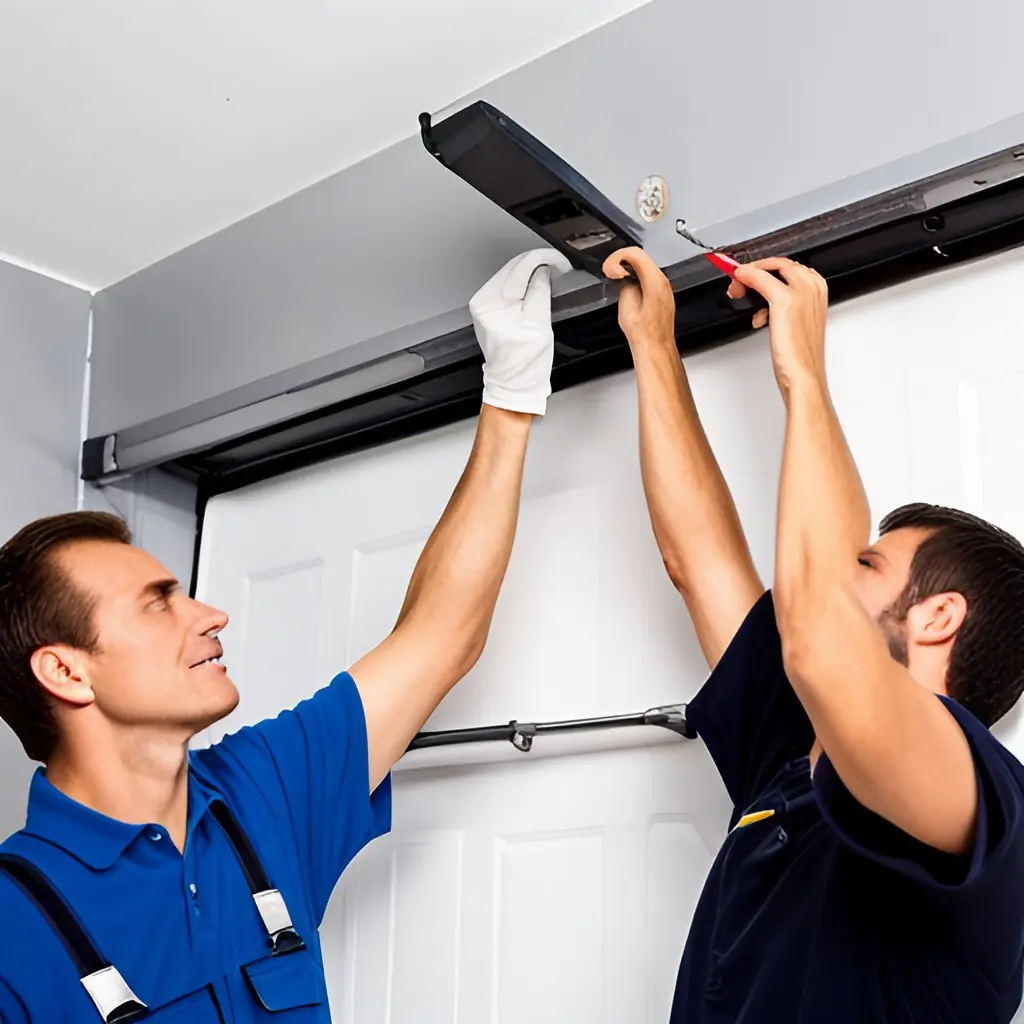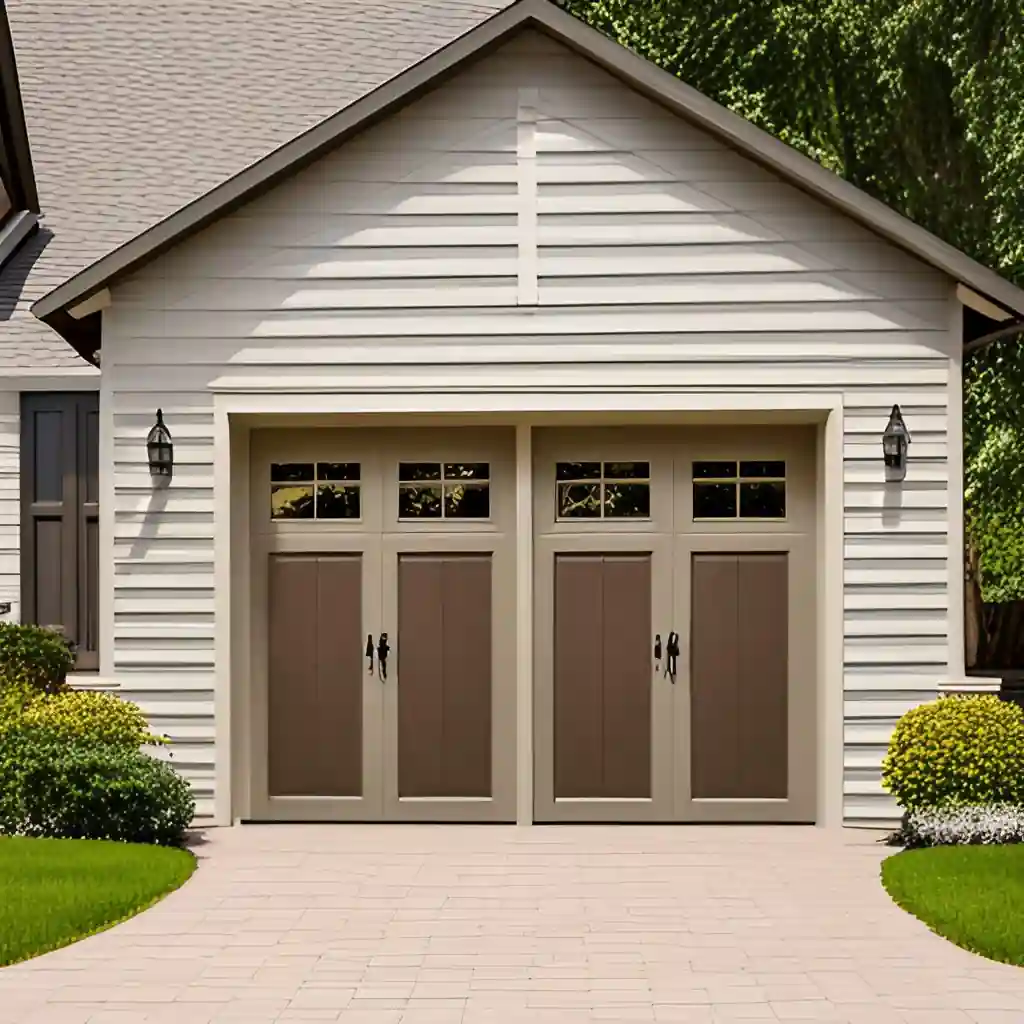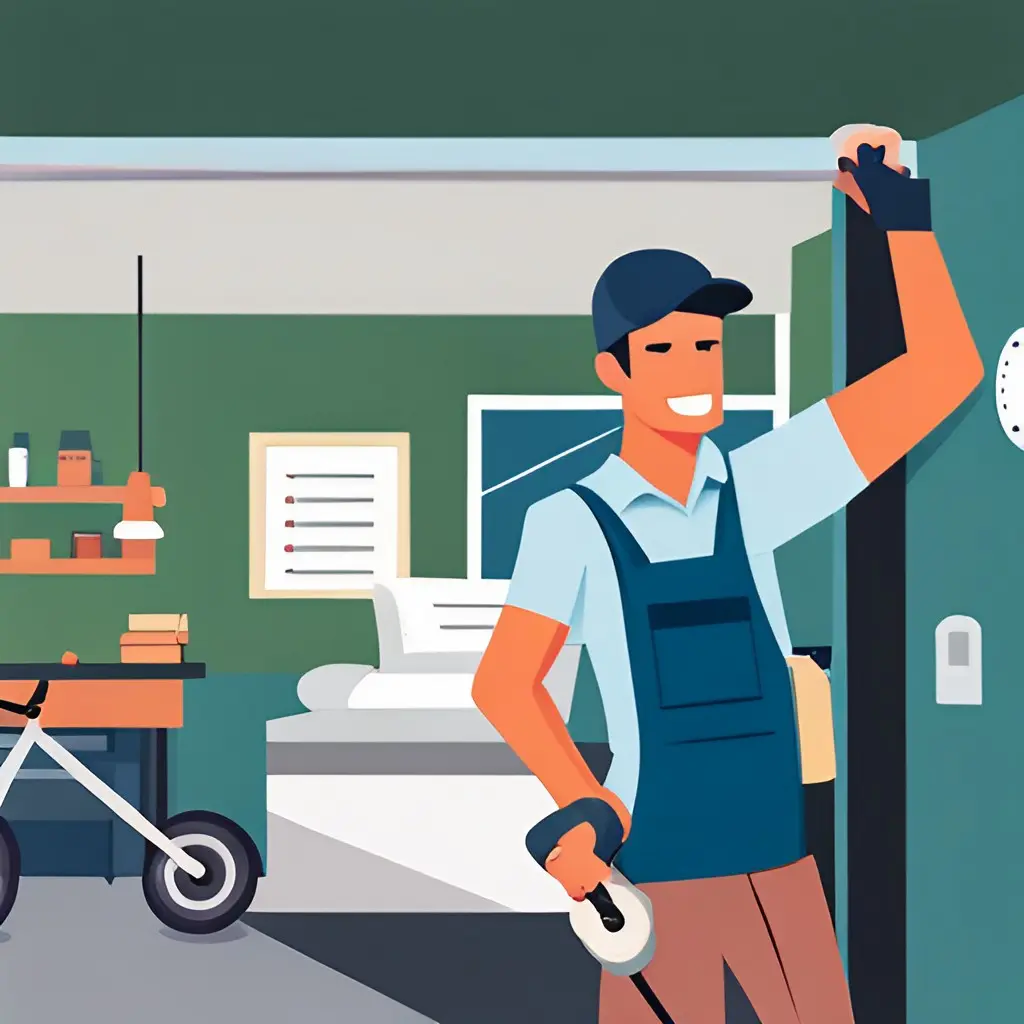In this blog post, we’ll guide you through the steps to troubleshoot and fix common garage door opener issues. We’ll also provide maintenance tips to help prevent future issues, saving you time and money in the long run.
This DIY guide is perfect for homeowners looking to learn some basic garage door opener maintenance and repair skills.
- Essential Tools and Materials for Garage Door Opener Repair
- Identifying the Problem
- Verify the Power Source and Batteries
- Check the Photo Eyes
- Inspect the Track and Rollers
- Test the Manual Release
- Examine the Torsion Spring and Cables
- Resetting or Reprogramming Your Garage Door Opener
- When to Call a Professional
- Still Facing Issues? Don’t Panic.
- Pro Tips
- Maintenance Tips to Prevent Future Issues
- Conclusion:
Your garage door opener is one of the most convenient features of your home, providing easy access to your vehicles and storage with just the click of a button.
However, when your garage door opener starts malfunctioning, it can become inconvenient and frustrating. Don’t worry; you don’t have to call a professional every time your opener stops working. With a little knowledge and some tools, you can fix most garage opener issues yourself.
Essential Tools and Materials for Garage Door Opener Repair
To troubleshoot and repair your garage door opener, you’ll need to have some basic knowledge about its components and how they work. As a homeowner with over a decade of experience in garage door maintenance and repair, I’ve identified key tools and materials that are essential for most DIY repairs.
Understanding the different parts of the opener, such as the motor, the remote control, and the safety sensors, is integral to successful repair. Additionally, a basic familiarity with electrical circuits and mechanisms, gained through my years of training and practical experience, can be very beneficial.
The following tools, which I’ve used extensively throughout my career, are typically required for most garage door opener repairs:
- Screwdriver: A set of both flathead and Phillips screwdrivers will be useful for various tasks.
- Adjustable wrench: This tool is essential for adjusting nuts and bolts.
- Pliers: These can help manipulate or hold parts while you’re working.
- Wire cutters: If you need to replace any wiring, these will come in handy.
- Voltage tester: This device, which I’ve relied on over the years to prevent electrical mishaps, can help you verify if electrical power is reaching the opener.
- Replacement parts: Depending on the issue, you may need to replace certain parts of the opener, such as the remote control, the motor, or the safety sensors. Be sure to check your garage door opener’s manual to determine the correct parts to use.
- Ladder: Since garage door openers are typically installed at a height, you’ll need a ladder to reach it comfortably.
Identifying the Problem
Before delving into troubleshooting your garage door opener, it’s vital to first identify the underlying issue. This could range from minor problems such as dead remote batteries to more serious complications like a faulty motor. Here are some key steps to help you pinpoint the problem:
Check the Remote Control
- Try the remote at different distances: It could be a range problem, so move closer to the garage door and test the remote again.
- Check the batteries: Sometimes, the issue could be as simple as dead batteries. If the batteries are weak or dead, replace them.
- Inspect for damages: Ensure that there’s no physical damage to the remote that might be affecting its functionality.
Inspect the Garage Door
- Examine the tracks: Look for any obstructions or debris in the tracks that could hinder the door’s movement.
- Check the rollers and springs: These should be in good condition and not display signs of wear and tear.
- Assess the door’s balance: If your garage door is not balanced, it can exert extra pressure on the opener, causing it to malfunction.
Listen for Unusual Noises
- Operate the door: While the door is in operation, listen for any unusual noises.
- Identify the noise: Rattling or grinding noises could imply loose hardware or a need for lubrication, while a humming noise when the door doesn’t move might suggest a stuck motor.
- Note the noise’s source: Pinpointing where the noise is coming from can provide clues about what might be wrong.
By following these steps, you can better understand what’s causing your garage door opener’s issue and begin taking steps toward fixing it.
Looking for garage storage: Fleximounts Overhead Garage Storage Installation: How-To

Verify the Power Source and Batteries
The proper functioning of your garage door opener highly depends on its power source and the batteries in the remote. Here is a step-by-step guide to verify and fix potential issues related to these two areas:
- Check the Power Supply: The opener should be plugged into an operative electrical outlet. Confirm that the outlet is functioning by testing it with another appliance.
- Inspect the Wiring: If the opener is hardwired into the electrical panel, make sure the wiring is secure and not frayed or damaged.
- Check the Circuit Breaker: If the garage door opener is connected to a dedicated circuit, ensure that the breaker hasn’t tripped. If it has, reset the breaker and try operating the opener again.
- Replace the Batteries in the Remote: If the remote control is not activating the door opener, it could be due to dead batteries. Open the battery compartment of the remote, take out the old batteries, and replace them with new ones. Be sure to observe the correct polarity when installing the batteries.
- Check the Reset Button: Some garage door openers have a reset button which, when pressed, restores the opener to its factory settings. If your opener has this button, try pressing it.
Remember, safety should always be your primary concern when dealing with electrical components. If you are unsure about any step, it’s best to consult with a professional.
Check the Photo Eyes
The safety sensors, also known as photo eyes, are key components of your garage door opener. Positioned on either side of the garage door, they serve as a safety mechanism to stop the door from closing onto objects or individuals obstructing its pathway.
Also read: How to Install Garage Door Sensors
If these sensors are dirty or misaligned, your garage door opener may not function as intended. Follow these steps to ensure they are in optimal condition:
Clean the Safety Sensors
Over time, dust and grime can accumulate on the sensors, impairing their functioning. Use a soft, lint-free cloth to gently wipe the surface of each sensor, being careful not to scratch or damage the lens.
Ensure Proper Alignment
Alignment is critical for the sensors to work effectively. They need to be facing each other directly and be at the same level.
Misalignment can cause the garage door opener to falsely detect an obstruction and prevent the door from closing. Check their alignment and adjust as necessary, ensuring they are parallel to each other and the ground.
Inspect the Track and Rollers
A garage door runs along a track with the help of rollers. If the track or rollers are obstructed, it can prevent the door from functioning smoothly. Here’s what to do:
Look for any obstructions or debris in the track: Remove any debris or obstructions from the track that may block the door’s path.
Check if the rollers are smoothly running on the track: Rollers should move smoothly on the track without resistance. If they aren’t, try lubricating them with a silicone-based spray or replacing them.
Test the Manual Release
The manual release is the emergency release cord located on the garage door opener. This cord allows you to manually open the garage door in case of an emergency or power outage. Here’s what to do:
Disengage the garage door opener: Pull the manual release cord to disengage the opener.
Manually move the garage door to check for resistance: If the door is hard to move or sticks along the track, there may be issues with the track or rollers that need attention.
Examine the Torsion Spring and Cables
The torsion spring and cables are crucial components of your garage door, working in conjunction to lift and lower the door. These parts are under significant tension, so their examination should be done with utmost caution.
Here are the steps to follow:
- Identify the parts: Locate the torsion spring and cables. The torsion spring is typically positioned horizontally at the top of the garage door, while the cables can be found on either side of the door, running vertically.
- Inspect the Torsion Spring: Look for any signs of wear and tear on the torsion spring. Pay particular attention to any gaps in the spring, which could indicate a break.
- Inspect the Cables: Closely examine the cables for any fraying, rust, or other damage.
If you discover any damage or degradation during your inspection, it is strongly recommended that these components be replaced by a professional due to their high tension and the potential risk of injury.
Resetting or Reprogramming Your Garage Door Opener
In case all the mentioned troubleshooting steps fail to resolve the issue, resetting or reprogramming your garage door opener might offer a solution. Here are the steps you need to follow:
- Refer to Your Manual: Every garage door opener model is unique and comes with a specific set of instructions for resetting or reprogramming. Check your brand’s user manual for detailed directives.
- Reset the Opener: Commonly, a garage door opener would have a reset button. Pressing this button will restore the opener to its default factory settings. However, this may vary between different models, so make sure to follow your manual’s directions.
- Reprogram Your Opener: Post a reset, you will need to reprogram your opener. This might involve setting a new remote control code or adjusting the door travel limits. Refer to your manual for precise instructions.
Remember, patience is key while reprogramming or resetting your garage door opener. If you still find the task daunting or if the problem persists, consider reaching out to a professional for assistance.
When to Call a Professional
While DIY fixes may work for simple garage door opener issues, some situations require professional help. Here’s when you should call in the experts:
- For issues with the torsion spring or cables: As mentioned earlier, these parts are under high tension and should only be handled by a professional.
- For issues with the garage door opener’s motor: If the motor is the root of the issue, it’s best to call a professional to repair or replace it.
- For safety reasons: If you’re uncertain about the issue or don’t feel comfortable with the repair process, don’t hesitate to call in a professional.
Still Facing Issues? Don’t Panic.
If you’ve followed all the steps above and are still facing issues with your garage door opener, don’t worry. It’s not uncommon to encounter complex problems that need more advanced solutions or technical expertise. If you’re in this situation, we recommend you:
- Recheck all steps: It’s easy to overlook small details, so go through the entire troubleshooting guide one more time. Pay extra attention to the steps that relate to the problem you’re facing.
- Reach out for support: There’s no shame in asking for help. Reach out to the customer support department of your garage door opener’s manufacturer. They may be able to provide insights or solutions specific to your model.
- Consult online forums or community groups: Sometimes, other users who have faced similar issues can provide innovative solutions or advice.
- Consider servicing: Regular maintenance and servicing by a professional can help to identify and resolve issues before they become significant problems, extending the lifespan of your garage door opener.
What If My Garage Door Opener Still Isn’t Working?
After following all the steps outlined above, you might still find your garage door opener isn’t working as expected. Don’t be discouraged; complex mechanisms like these can sometimes pose unique challenges. Here are a few commonly asked questions and additional troubleshooting steps that could help:
Why is my garage door opener remote not working?
If your remote isn’t working, it could be due to dead batteries, poor range, or frequency interference. Try replacing the batteries, moving closer to the door, or resetting the remote’s frequency. If none of these solutions work, your remote might need to be replaced.
Why does my garage door opener work intermittently?
An intermittent garage door opener could be due to fluctuating power supply, binding tracks, or temperature changes affecting the sensitivity of your opener’s motor. Check your power source, ensure the tracks are free from obstructions, and consider whether recent weather changes may have affected your opener’s performance.
Why is my garage door opener making a grinding noise but the door isn’t moving?
A grinding noise might indicate a problem with the gears or the track. Inspect these parts for any obvious issues. If you can’t find the issue, it’s time to call in an expert.
Remember, while these troubleshooting steps can help with minor issues, safety should be your top priority. If you’re uneasy about any steps or if the problem persists, don’t hesitate to contact a professional garage door technician.
Pro Tips
- Keep a maintenance log: Write down the dates of all maintenance, inspections, and repairs performed on your garage door opener. This will help you troubleshoot future issues and provide useful information for professionals if needed.
- Regularly update your knowledge: Even if you’re confident in your skills, it’s always a good idea to regularly update your knowledge. New troubleshooting methods and maintenance techniques are constantly being developed.
- Invest in quality parts: Using high-quality parts can increase the longevity of your garage door opener and reduce the frequency of issues. This is especially true for crucial components like the torsion spring, cables, and motor.
- Safety first: Never compromise on safety. If you’re unsure about any step or if it involves high-risk components, always call a professional.

Maintenance Tips to Prevent Future Issues
To ensure the smooth operation of your garage door opener and prevent potential issues, heed the following maintenance tips. Adhering to these guidelines will not only enhance the longevity of your device but also save you time and unnecessary repair costs.
- Regular Lubrication: Apply a silicone-based lubricant to the tracks, rollers, and hinges every three months. This helps to reduce friction, ensuring that the moving parts of your garage door opener function smoothly and effectively.
- Timely Replacement of Worn-out Parts: Regularly inspect all components of the garage door opener. Look for signs of wear and tear, especially in the springs, cables, and pulleys, and replace the worn-out parts promptly to prevent more complicated issues.
- Routine Inspection: Conduct a thorough inspection of your garage door and its opener every six months. Check the alignment of the door, the condition of the torsion spring and cables, and the functionality of the sensors. This proactive approach can help you detect and fix problems early.
- Test the Balance and Alignment: Disconnect the garage door from the opener and manually open it halfway. If it doesn’t stay put, the balance might be off. Call a professional to adjust it, as this issue can wear out the opener.
- Check the Auto-Reverse Safety Features: Test both the mechanical and photoelectric auto-reverse features of your garage door opener. For the mechanical feature, place a block of wood on the ground where the door would close. If the door doesn’t reverse after hitting the wood, you may need to have it repaired. For the photoelectric system with beams at each side, close your door and just pass your leg in the door’s path. If the door doesn’t reverse, the photoelectric system needs repair.
- Clean the Tracks: Clean the tracks to remove any buildup of dust or debris. This helps the door to roll smoothly.
- Tighten Loose Components: Over time, the vibration of the door can loosen hardware parts such as bolts and nuts. Check these components regularly and tighten them if necessary.
- Update Your Knowledge: Stay updated with the latest maintenance techniques and best practices. This can help you to better identify potential issues and understand when to call a professional for help.
By incorporating these maintenance tips into a routine schedule, you can ensure the optimal performance of your garage door opener and prevent future issues.
Conclusion:
In conclusion, fixing a garage door opener issue isn’t always a job for a professional. By following the steps outlined in this DIY guide, you can troubleshoot and fix many issues yourself.
Remember to prioritize safety and use caution when handling certain parts, like the torsion spring and cables.
Regular maintenance can help prevent future issues and make your garage door opener last for years to come. If you have any questions or issues not covered in this post, don’t hesitate to call in a professional or reach out to your garage door opener manufacturer for further assistance.

I’m J.S., I created and am the content manager at DIYHouseSkills.com. I do the research and write the articles that appear on this website. I’ve learned many household skills during my life and think it’s important to at least know the basics so that you can save yourself time and money… READ FULL BIO >
- Outlet Not Working, Breaker Not Tripped | Advice
- How to Repair a Sage Coffee Machine
- Mastering the Power Drill: Tips for Effective & Safe Use
- Fixing Leaky Faucets: A Step-by-Step Guide
- Change Your Bathroom Sink Faucet The Easy Way
- Your Guide to DIY Door Handle Replacement
- Washer Won’t Drain Water – How to Troubleshoot and Fix
- Washing Machine Shakes or Bounces -Here’s How to Solve It

